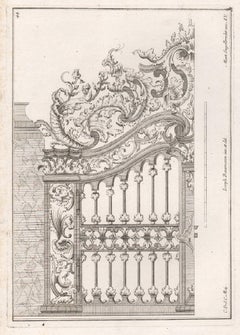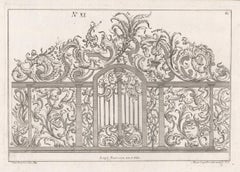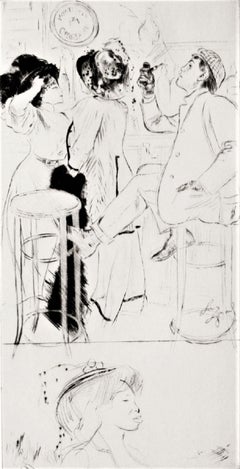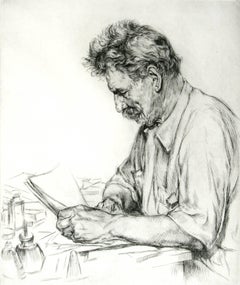Joseph Baumann Art
to
2
Overall Width
to
Overall Height
to
2
2
2
1
1
1
1
1
2
2
2
10,042
2,761
1,381
1,375
Artist: Joseph Baumann
Rococo design for a gate, German mid 18th century etching
By Joseph Baumann
Located in Melbourne, Victoria
Rococo design for a gate, etching, by Joseph Baumann (active 1740-1760), circa 1750.
Published by Martin Engelbrecht (1684–1756).
Similar works ar...
Category
Mid-18th Century Rococo Joseph Baumann Art
Materials
Engraving, Etching
Rococo design for a gate, German mid 18th century etching
By Joseph Baumann
Located in Melbourne, Victoria
Rococo design for a gate, etching, by Joseph Baumann (active 1740-1760), circa 1750.
Published by Martin Engelbrecht (1684–1756).
Similar works ar...
Category
Mid-18th Century Rococo Joseph Baumann Art
Materials
Engraving, Etching
Related Items
Sportsmen
By Louis Legrand
Located in Storrs, CT
Sportsmen. 1908. Etching and drypoint. Exsteens 271.i/ii. 11 1/4 x 5 3/4 (sheet 17 3/8 x 12 1/4). Series: Les Bars. From the first state edition of 30 proofs with the remarque sketch...
Category
Early 1900s Post-Impressionist Joseph Baumann Art
Materials
Drypoint, Etching
Portrait of Albert Schweitzer.
By Arthur William Heintzelman
Located in Storrs, CT
Portrait of Albert Schweitzer. Etching. 11 3/4 x 9 3/4 (sheet 16 1/4 x 14). Illustrated: Beall, American Prints in the Library of Congress, page 205....
Category
1950s American Modern Joseph Baumann Art
Materials
Etching, Drypoint
$750 Sale Price
50% Off
H 11.75 in W 9.75 in D 0.5 in
Hidden Cities III: Continuum, by Peter Milton
By Peter Milton
Located in Palm Springs, CA
Peter Milton’s Hidden Cities: Continuum transforms the grandeur of the Galleria Vittorio Emanuele into a layered meditation on architecture, memory, and the passage of time. The Gall...
Category
Early 2000s Contemporary Joseph Baumann Art
Materials
Engraving, Etching
Points of Departure: Mary's Turn, by Peter Milton
By Peter Milton
Located in Palm Springs, CA
Peter Milton’s Mary’s Turn reimagines a scene where Mary Cassatt and Edgar Degas engage in a game of billiards, reflecting their real-life friendship and rivalry. Cassatt leans forwa...
Category
1990s Contemporary Joseph Baumann Art
Materials
Engraving, Etching
William Hogarth's "Analysis of Beauty": A Set of Two Framed 18th C. Engravings
By William Hogarth
Located in Alamo, CA
The two plates in this set were created utilizing both engraving and etching techniques by William Hogarth in 1753, originally as illustrations of his book on aesthetics, entitled "Analysis of Beauty". Due to their popularity, these plates were later published separately. The publication line in the lower right reads: "Designed, Engraved, and Publish'd by Wm. Hogarth, March 5th 1753, according to Act of Parliament." Hogarth's original copper plates were refurbished where needed by James Heath and engravings were republished in London in 1822 by Braddock, Cradock & Joy. This was the last time Hogarth's copper plates were used for printing. Most were melted during World War I for the construction of bombs.
These large folio sized "Analysis of Beauty" engravings are presented in antiqued gold-colored frames with double mats; the outer silk mats are light brown-colored and the inner mats are dark brown. Each frame measures 27.38" x 31.25" x 1.13". There is one tiny spot in the right margin of plate 1 and another in the lower margin; the latter could be from the printing process. The prints are otherwise in excellent condition.
The "Analysis of Beauty" series is in the collection of many major museums, including: The British Museum, The Metropolitan Museum of Art, The Tate Museum, The Chicago Art Institute and The Fine Arts Museums of San Francisco.
The first engraving (Plate 1) depicts a courtyard of statues which is filled with some of the most famous works of classical sculpture. The most important sculptures are surrounded by less impressive works. The Medicean Venus (#13) is in the center with a statue of Julius Caesar (#19) to the right, elevated on a pulley with a short, overdressed Brutus stands over the falling Caesar. The Apollo Belvedere (#12) is next. A judge stands to the right with his foot on a cherub (#16). Another crying cherub holds a gallows and wipes his tears with the judge's robe.
A sphinx (#21) and the drunken Silenus (#107) are below the Venus. Michaelangelo's torso (#54) and a statue of Antonius (#6) are seen in the foreground. The Farnese Hercules (#3) and a bust of another Hercules (#4) under two statuettes of Isis are also included in the scene.
The key to these objects is included in the form of a serpentine line winding around a cone (#26), Hogarth's "Line of Beauty". For Hogarth the winding line is an essential element of beauty in art. Hogarth's theory of beauty is communicated in this plate.
Plate 2 is thought to represent the Wanstead Assembly, with the Earl of Tynley and his household. It is an adaptation of a scene in the Happy Marriage series, which complements Hogarth's Marriage à la Mode...
Category
Mid-18th Century Old Masters Joseph Baumann Art
Materials
Engraving, Etching
$2,975
H 27.38 in W 31.25 in D 1.13 in
Returning to the Stable.
By Edmund Blampied
Located in Storrs, CT
Returning to the Stable. 1920. Drypoint. Appleby 64. 8 3/4 x 12 1/4 (sheet 11 7/16 x 16 1/8). Edition 100. A rich impression printed on cream laid paper wi...
Category
1920s Modern Joseph Baumann Art
Materials
Drypoint, Etching
Daylilies, by Peter Milton
By Peter Milton
Located in Palm Springs, CA
Peter Milton’s Daylilies is a haunting meditation on memory, mortality, and the layered complexity of personal and cultural history. Like much of Milton’s work, the print operates le...
Category
1990s Contemporary Joseph Baumann Art
Materials
Engraving, Etching
Newspapers on the Table - Still Life Etching on Heavy Paper
Located in Soquel, CA
Newspapers on the Table - Still Life Etching on Heavy Paper, #20/150
Black and white etching by Darien Payne (American, b. 1951). This piece is a meticulously detailed depiction of ...
Category
1990s Photorealist Joseph Baumann Art
Materials
Archival Paper, Drypoint, Etching
$925
H 16.5 in W 12.5 in D 1 in
Night Time in a Stable.
By Edmund Blampied
Located in Storrs, CT
Night Time in a Stable. 1927-28. Drypoint. Appleby 131. 10 1/8 x 12 1/8 (sheet 11 1/2 x 16 1/2). Edition 100. Illustrated: Print Collector's Quarterly 25 (1...
Category
Early 20th Century Modern Joseph Baumann Art
Materials
Drypoint, Etching
Interiors VI: Soundings
By Peter Milton
Located in New York, NY
Contemporary artist Peter Milton created this etching and engraving entitled "Interiors VI: Soundings" in 1989. The printed image size is 29 7/8 x 23 13/16 and paper size is 36 x 29 inches. This impression is signed, dated, and titled in pencil and inscribed “93/175” – the 93 impression of 175.
“I do love to draw. I feel that I am being granted membership in the Brotherhood of Merlin, conjuring forth some apparition. As a drawing develops, I sense a vague presence coming more and more into focus, something in a white fog emerging and becoming increasingly palpable.” – P. Milton, “The primacy of touch. The Drawings of Peter Milton”
“Working in layers, Milton begins with drawings based on people and places, with nods to Western art history and culture. He is a master of the appropriated image, a term that may conjure Andy Warhol and his Pop Art comrades. But Milton steps further back in history, avoiding the Pop sense of cool advertising and popular culture references. Instead, a broader cultural past is tapped through historical photographs of key players, architecture, and locales, which he reinvents by hand. He adds content drawn from his life as an avid reader – always with multiple possible interpretations – thus incorporating deeper meaning in his cinematic worlds. Elements of Greek mythology, classical music, art history, and history coalesce in his images, which embrace the messiness, sorrow, and elation that is life. One is hard-pressed to imagine a more erudite, skilled, passionate, and cheeky soul."
– T. L. Johnson and A. Shafer
Peter Milton was born in Pennsylvania in 1930. He studied for two years at the Virginia Military Institute...
Category
Late 20th Century Surrealist Joseph Baumann Art
Materials
Engraving, Etching
Les Belles et la Betes II: Before The Hunt, by Peter Milton
By Peter Milton
Located in Palm Springs, CA
Peter Milton’s Les Belles et la Bête: Before the Hunt shows his ability to weave together fantasy, art history, and the subconscious into a single intricate vision. The print stages ...
Category
1970s Contemporary Joseph Baumann Art
Materials
Engraving, Etching
Parmigiani Amica: An 18th Century Engraving and Etching by Strange After Mazzola
Located in Alamo, CA
This is an 18th century engraving and etching entitled "Parmigiani Amica" by Robert Strange after a painting by Girolamo Francesco Maria Mazzola, better known as Parmigianino, who lived during the Renaissance period. It was published in London in 1774. As the inscription states, the painting was in the collection of the King of Naples at the time the engraving was made. The engraving depicts a half-length portrait of a young woman, known as Parmigiani's Amica (meaning "female friend" in Italian). She is depicted wearing a simple but elegant dress with a low-cut neckline, which reveals her delicate features and graceful neck. Her hair is arranged in a simple yet stylish manner. She is turning to the right to look lovingly at her infant, which she is holding with her right arm. She is touching the baby's mouth with her left hand. The background of the engraving is plain and unadorned, allowing the viewer to focus entirely on the subject of the portrait. The result is a beautiful and timeless image that captures the essence of Renaissance portraiture.
The engraving is printed on watermarked paper. The sheet measures 16.25" high and 12' wide. The sheet is adhered to paper in its upper corners and it has been removed from the paper in its lower corners. There is some mild discoloration and some wrinkling in the margins, including the lower inscription area, and a small dark spot in the upper margin, which may represent a drop of ink occuring at the time of printing. These issues do not involve the image, which is in very good condition. The print is held by several museums and institutions, including: The Metropolitan Museum of Art in New York, The British Museum in London, The Royal Museums of the UK, The British National Trust...
Category
Late 18th Century Joseph Baumann Art
Materials
Engraving, Etching
$1,875
H 16.25 in W 12 in
Joseph Baumann art for sale on 1stDibs.
Find a wide variety of authentic Joseph Baumann art available for sale on 1stDibs. You can also browse by medium to find art by Joseph Baumann in engraving, etching and more. Not every interior allows for large Joseph Baumann art, so small editions measuring 15 inches across are available. Customers who are interested in this artist might also find the work of and Matthaeus Merian. Joseph Baumann art prices can differ depending upon medium, time period and other attributes. On 1stDibs, the price for these items starts at $165 and tops out at $165, while the average work can sell for $165.



